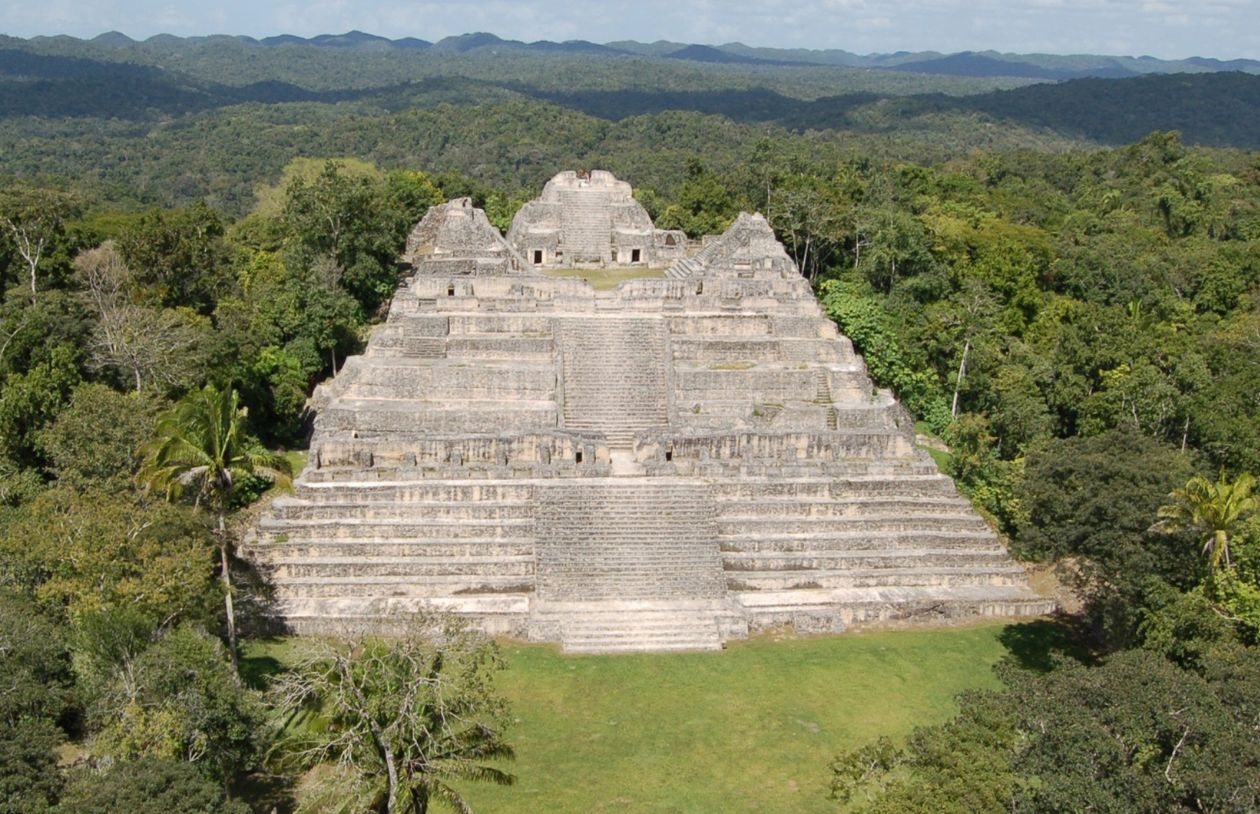Caana, the central architectural complex at Caracol, Belize, uncovered by Diane and Arlen Chase in the 1980s
Archaeologists from the University of Houston working at Caracol in Belize, Central America have uncovered the tomb of Te K’ab Chaak, the first ruler of this ancient Maya city and the founder of its royal dynasty. Now in ruins, this metropolis was a major political player in Maya history, dominating the southern part of the Yucatan Peninsula from 560 through 680 AD before its abandonment by 900 AD.
The discovery is the first identifiable ruler’s tomb found in over four decades of work in Caracol, the largest Maya archaeological site in Belize and in the Maya lowlands.
Te K’ab Chaak, who acceded to the throne in 331 AD, was interred at the base of a royal family shrine with eleven pottery vessels, carved bone tubes, jadeite jewelry, a mosaic jadeite mask, Pacific spondylus shells, and other perishable materials. Pottery vessels in the chamber included a scene of a Maya ruler holding a spear and receiving offerings from supplicants in the form of deities. Another vessel portrays the image of Ek Chuah, Maya god of traders, surrounded by offerings. Four of the pottery vessels portray bound captives (similar vessels also appeared in two related burials). Two vessels supported lids with modeled handles of coatimundi (pisote) heads. The coatimundi, or tz’uutz’ in Maya, was used by subsequent Caracol rulers as part of their names.
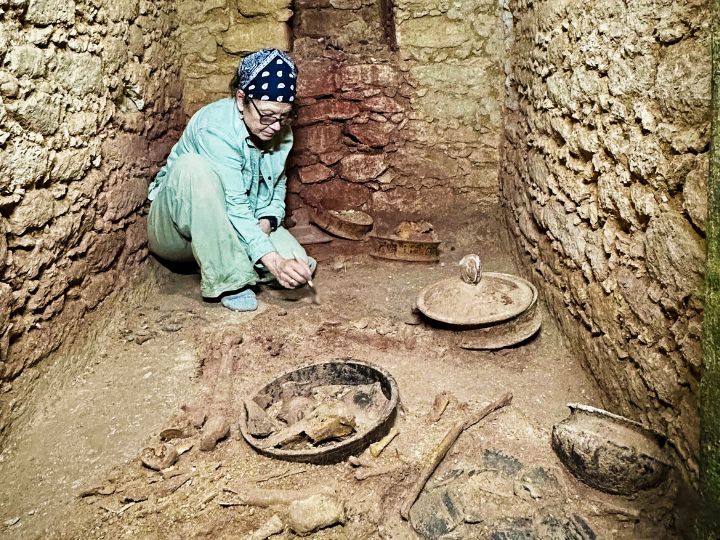
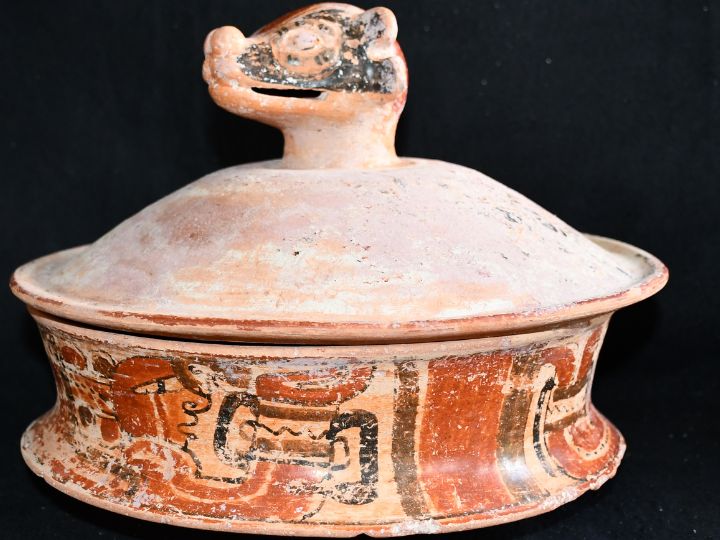
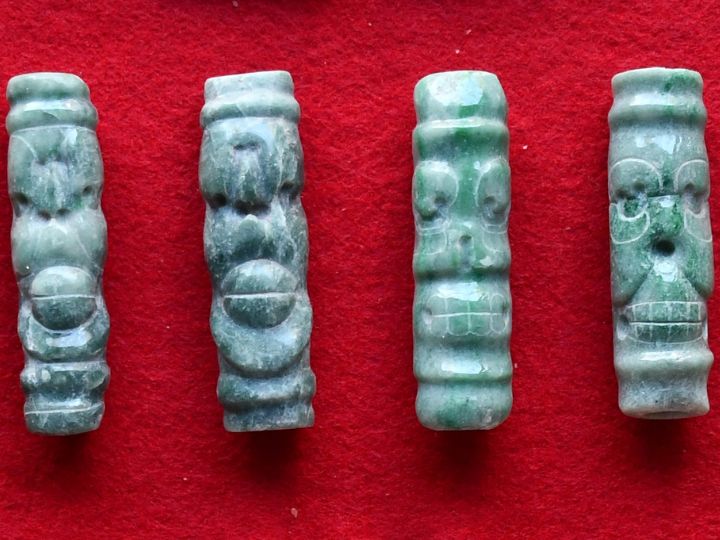
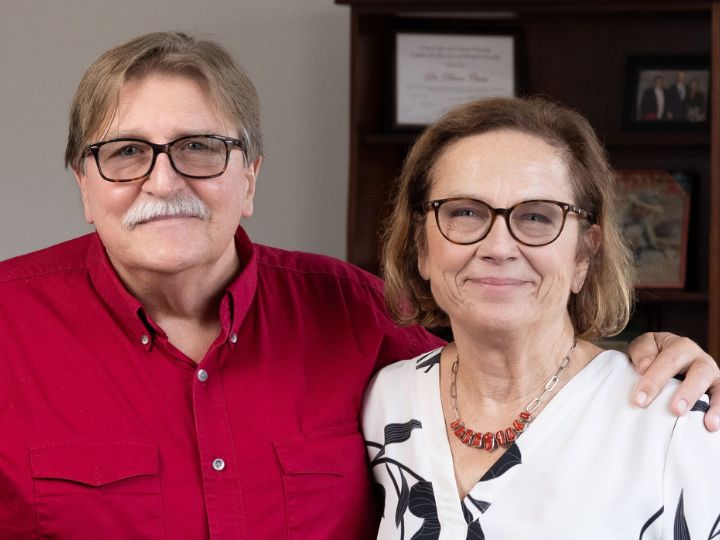
A team led by husband and wife collaborators Arlen F. Chase and Diane Z. Chase of the University of Houston has been excavating at Caracol for more than 40 years; this field season was carried out in concert with Belize’s Institute of Archaeology and was supported by the Alphawood Foundation, the University of Houston, the Geraldine and Emory Ford Foundation, and the KHR Family Fund.
The Chases estimate that at the time of his burial the ruler was of advanced age and approximately 5’7” in height. He had no remaining teeth.
Their investigations at Caracol’s Northeast Acropolis show that Te K’ab Chaak’s tomb was the first of three major burials dating to about 350 AD, a time of early contact with the central Mexican city of Teotihuacan, some 1200 kilometers distant. By 300 AD, Teotihuacan was a huge city that traded throughout Central America.
“One question that has perplexed Maya archaeologists since the 1960s is whether a new political order was introduced to the Maya area by Mexicans from Teotihuacan,” said Diane Z. Chase, archaeologist and senior vice president for academic affairs and Provost at the University of Houston.
“Maya carved stone monuments, hieroglyphic dates, iconography, and archaeological data all suggest that widespread pan-Mesoamerican connections occurred after an event in 378 AD referred to as ‘entrada,’” said Diane Chase.
“Whether this event represented actual Teotihuacanos in the Maya area or Maya using central Mexican symbols is still debated. The Caracol archaeological data suggests that the situation was far more complicated,” she said.
A cremation placed in the center of Caracol’s Northeast Acropolis plaza, recovered in 2010 and placed after Te K’aab Chaak’s burial has been dated to AD 350 by radiocarbon analysis and included artifacts from central Mexico. It contained the remains of three individuals, as well as two large knives, six atlatl points, and fifteen pristine blades of green obsidian from Pachuca, Mexico (north of Teotihuacan); several pottery vessels also likely came from central Mexico. Additionally, a carved atlatl projectile tip, atypical for the Maya but typical for a Teotihuacan warrior, was included in the cremation.
The cremation itself and its placement in the center of a residential plaza are also more typical practices for a high-status Teotihuacano and do not accord with standard Maya burial practices. Based on other ceramics in this cremation, the main individual was likely a Caracol royal family member that had adopted central Mexican ritual practices. This individual may even have served as a royal Maya envoy who had lived at Teotihuacan and returned to Caracol.
A third burial — the tomb of a woman, also covered with hematite and containing four pottery vessels, a spondylus bead necklace, mirror fragments, and two Pacific spondylus shells — was recovered in the northern building of the same residential group in 2009 and is similarly dated.
The three burials interred in the Caracol Northeast Acropolis all cluster at AD 350, at least a generation before the previously recognized Teotihuacan presence in the Maya area. They demonstrate that early Maya rulers were fully enmeshed in Mesoamerican-wide contacts prior to the Teotihuacan entrada recorded on Maya monument[s].
“Both central Mexico and the Maya area were clearly aware of each other’s ritual practices, as reflected in the Caracol cremation, said Arlen F. Chase, professor and chair of Comparative Cultural Studies at the University of Houston.
“The connections between the two regions were undertaken by the highest levels of society, suggesting that initial kings at various Maya cities — such as Te K’ab Chaak at Caracol — were engaged in formal diplomatic relationships with Teotihuacan,” said Arlen Chase
The royal dynasty established by Te K’ab Chaak continued at Caracol for over 460 years.
The Chase’s findings also indicate that ancient peoples in the new world were travelers. A trip between Teotihuacan and Caracol today by car would take over 23 hours. The one-way walking time may be estimated to be approximately 153 days.
Research continues on the contents of the chamber with the reconstruction of the jadeite death mask and with ancient DNA and stable isotope analysis of the skeletal material. The Chases will present results of the 2025 Caracol field season at a conference on Maya–Teotihuacan interaction hosted by the Maya Working Group at the Santa Fe Institute (New Mexico) in August 2025.
About the Chases
Married since 1975, Diane and Arlen Chase are two of the most influential Maya archaeologists in the world, and the foremost experts on Caracol, one of the most significant ancient Maya cities.
Since their first dig in 1985, the Chases have become known for:
- Providing a nuanced picture of Caracol’s ancient landscape and people, including recognition of Caracol as a city of advanced urban planning, road systems and markets and a large non-elite population upending the notion of a strict Maya social hierarchy. In 1986 they discovered an inscription that told of Caracol’s military victory over Tikal in 562 AD, overturning the myth that Tikal was the most powerful Classic Period city and illustrating that Caracol was a major military and political power.
- Using airborne LiDAR (light detection and ranging) technology to uncover structures hidden for centuries under dense jungle, revolutionizing how archaeologists explore Maya sites. Their work from the 1980s-2000s revealed a web of interconnected roadways, proving that Caracol was a massive, urban and integrated city.
- Overturning outdated beliefs about the Maya, while providing new insights. Their archaeological work has shown that ancient Maya society was composed of many different social gradients, contrary to more simple two-class models. From the 1980s -2000, they and their team mapped numerous causeways (or roads) and thousands of agricultural terraces spread out across Caracol as well as hundreds of reservoirs in non-elite areas, proving that water, sacred to the Maya, was not controlled by the elite, as previously thought. The Chases’ son, Adrian Chase, also an archaeologist, found that Caracol had a decentralized water system and that residential groups had their own access. He is currently studying the urban structure of Caracol and changes in governance over time.
The Chases will present detailed information on the tomb and other finds from Caracol at the Santa Fe Institute in August.
See Feature Story